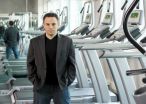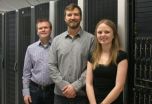(Press-News.org) Icahn School of Medicine at Mount Sinai researchers have linked high levels of exposure to inhaled particulate matter by first responders at Ground Zero to the risk of obstructed sleep apnea and post-traumatic stress disorder (PTSD), both conditions that may impact cardiovascular health.
The two separate studies were both presented on March 20 at the American Heart Association's EPI/NPAM 2014 Scientific Sessions in San Francisco, California by cardiologist Mary Ann McLaughlin, MD, MPH, principal investigator for the WTC-CHEST Program at Mount Sinai, a subset of the World Trade Center Health Program Clinical Center for Excellence at Mount Sinai.
"Our study shows high exposure to the massive dust cloud of air pollution at Ground Zero has increased the risk among first responders of both obstructive sleep apnea and PTSD," says Dr. McLaughlin of the WTC-CHEST Program at Mount Sinai. "As a result, this puts our 9/11 first responders at higher risk of developing heart disease."
Due to 9/11 tragedy first responders at Ground Zero were exposed to varying levels of a dust cloud of air filled with cement dust, smoke, glass fibers, and heavy metals. The WTC-CHEST Program at Mount Sinai has previously linked this particulate matter exposure to lung, heart, and kidney disease abnormalities. Now the research team's studies found further research evidence linking sleep apnea and PTSD to exposure of the 9/11 particulate matter.
In each of the two analyses, researchers studied the same WTC-CHEST Program population of more than 800 participants between January 2011 to September 2013 with varying exposure to particulate matter ranging from very high, high, intermediate, and low, taking into account each first responder's time of arrival, proximity, duration, and level of exposure at Ground Zero.
"Elevated exposure to the particulate matter from 9/11 caused upper airway inflammation and is a significant contributing factor to the pathogenesis of obstructive sleep apnea," says Dr. McLaughlin. "There is strong evidence in our study data showing a significant risk of inhaled particulate matter exposure and risk of obstructed sleep apnea in the studied group of WTC first responders."
In addition, researchers linked particulate matter inhalation to the high risk of PTSD. Study results show those with very high or high exposure were more likely to have PTSD. Also, they found that those responders with PTSD also had elevated biomarkers for increased cardiovascular disease risk including high sensitivity C-reactive protein (hsCRP), a key biomarker of inflammation indicative of increased cardiovascular risk. Those WTC responders with PTSD had significantly higher hsCRP levels.
"High levels of exposure to particulate matter may lead to sleep apnea and PTSD, and as a result a high risk factor for cardiovascular disease," says Dr. McLaughlin. "As a result of our new study findings, we plan to further closely monitor our WTC first responders for heart disease warning signs."
This research study was funded by the Centers for Disease Control and Prevention (CDC) and the National Institute of Occupational Safety and Health (NIOSH).
Dr. McLaughlin is the principal investigator for the WTC-CHEST Program at Mount Sinai evaluating the effects of exposure in WTC responders 10-14 years following the events of 9/11. The research studies seek to further examine the relationship between pulmonary and cardiac function abnormalities, other markers of chronic cardiopulmonary disease, kidney dysfunction, and further elucidate the pathophysiologic effects of exposure to inhaled particulate matter on 9/11.
The WTC Health Program, Clinical Center of Excellence at Mount Sinai is a treatment and monitoring program for emergency responders, recovery workers, residents, and area workers who were affected by the terrorist attacks in New York City on September 11, 2001. The program identifies mental and physical health problems needing timely treatment; evaluates the health of first responders; monitors the development of symptoms; and researches the effects of 9/11 through data collection and analysis. Located at Mount Sinai and several other clinics in the tri-state area, the Clinical Centers of Excellence and Data Centers are the result of the James Zadroga 9/11 Health and Compensation Act, which provides $4.3 billion in federal funding to serve the health needs of the brave men and women impacted by the WTC tragedy.
INFORMATION:
About the Mount Sinai Health System
The Mount Sinai Health System is an integrated health system committed to providing distinguished care, conducting transformative research, and advancing biomedical education. Structured around seven member hospital campuses and a single medical school, the Health System has an extensive ambulatory network and a range of inpatient and outpatient services—from community-based facilities to tertiary and quaternary care.
The System includes approximately 6,600 primary and specialty care physicians, 12-minority-owned free-standing ambulatory surgery centers, over 45 ambulatory practices throughout the five boroughs of New York City, Westchester, and Long Island, as well as 31 affiliated community health centers. Physicians are affiliated with the Icahn School of Medicine at Mount Sinai, which is ranked among the top 20 medical schools both in National Institutes of Health funding and by U.S. News & World Report. For more information, visit http://www.mountsinai.org/.
Find Mount Sinai on:
Facebook: http://www.facebook.com/mountsinainyc
Twitter: http://www.twitter.com/mountsinainyc
YouTube: http://www.youtube.com/mountsinainy
9/11 linked to 3 heart disease culprits: Obstructive sleep apnea and PTSD
Icahn School of Medicine at Mount Sinai reports new findings showing WTC first responders are at higher risk for obstructive sleep apnea and PTSD
2014-03-21
ELSE PRESS RELEASES FROM THIS DATE:
Diet of elusive red widow spider revealed by MU biologist
2014-03-20
COLUMBIA, Mo. – Beetles: it's what's for breakfast—at least for the red widow spider of Florida's "scrub" habitat, according to a study by University of Missouri biologist James Carrel. The study provides a first glimpse at the diet of this mysterious spider, revealing that it primarily preys upon species of scarab beetles common to the scrub habitat. Carrel's findings shed light on red widow spiders' restriction to the Florida scrub habitat and the need for habitat conservation efforts.
"The pine scrub habitat, found on sandy ridges in Central and Southeastern Florida, ...
Dramatic new portrait helps define Milky Way's shape, contents
2014-03-20
MADISON, Wis. – Using more than 2 million images collected by NASA's orbiting Spitzer Space Telescope, a team of Wisconsin scientists has stitched together a dramatic 360 degree portrait of the Milky Way, providing new details of our galaxy's structure and contents.
The new composite picture (viewable at http://www.spitzer.caltech.edu/glimpse360), using infrared images gathered over the last decade, was unveiled today (March 20, 2014) at a TED conference in Vancouver. The galactic portrait provides an unprecedented look at the plane of our galaxy, using the infrared imagers ...
Not only is she thinner than you ... her muscles work better, too
2014-03-20
Bethesda, MD (March 20, 2014)—We all know the type: The friend or colleague who stays slim and trim without much effort and despite eating the same high-calorie fare that causes everyone else to gain weight. As it turns out, the way the muscles of the inherently thin work may give them the edge.
Daily physical activity is an inherited trait with a strong association to how fat or thin a person is. Chaitanya K. Gavini et al. previously found that aerobic capacity is a major predictor of daily physical activity level among humans and laboratory animals. In their new study, ...
New semiconductor holds promise for 2-D physics and electronics
2014-03-20
From super-lubricants, to solar cells, to the fledgling technology of valleytronics, there is much to be excited about with the discovery of a unique new two-dimensional semiconductor, rhenium disulfide, by researchers at Berkeley Lab's Molecular Foundry. Rhenium disulfide, unlike molybdenum disulfide and other dichalcogenides, behaves electronically as if it were a 2D monolayer even as a 3D bulk material. This not only opens the door to 2D electronic applications with a 3D material, it also makes it possible to study 2D physics with easy-to-make 3D crystals.
"Rhenium ...
One-third of kids with obesity 'metabolically healthy,' study shows
2014-03-20
(Edmonton) Digits on a scale can help determine a child's weight, but their overall health status can be influenced by other factors such as physical activity, diet and screen time, according to new research from the University of Alberta and Alberta Health Services.
A study of 181 children with obesity aged eight to 17 years old showed that up to a third could be classified as "metabolically healthy," meaning they're not imminently at risk of developing insulin resistance—a precursor to Type 2 diabetes—high blood pressure, high cholesterol or other obesity-related diseases.
"It's ...
Pseudogap theory puts physicists closer to high temperature superconductors
2014-03-20
Physicists are one step closer to developing the world's first room-temperature superconductor thanks to a new theory from the University of Waterloo, Harvard and Perimeter Institute.
The theory explains the transition phase to superconductivity, or "pseudogap" phase, which is one of the last obstacles to developing the next generation of superconductors and one of the major unsolved problems of theoretical condensed matter physics.
Their work was published in this week's issue of the prestigious journal Science.
Superconductivity is the phenomenon where electricity ...
Potential lung cancer vaccine shows renewed promise
2014-03-20
(SACRAMENTO, Calif.) — Researchers at UC Davis have found that the investigational cancer vaccine tecemotide, when administered with the chemotherapeutic cisplatin, boosted immune response and reduced the number of tumors in mice with lung cancer. The study also found that radiation treatments did not significantly impair the immune response. The paper was published on March 10 in the journal Cancer Immunology Research, an American Association for Cancer Research (AACR) publication.
Though tecemotide, also known as Stimuvax, has shown great potential at times, the recent ...
Ancient clam gardens nurture food security
2014-03-20
A three-year study of ancient clam gardens in the Pacific Northwest has led researchers, including three from Simon Fraser University, to make a discovery that could benefit coastal communities' food production. PLOS ONE, a peer-reviewed science journal, has just published their study.
Amy Groesbeck, an SFU alumna, SFU professors Anne Salomon, an ecologist, and Dana Lepofsky, an archaeologist, and Kirsten Rowell, a University of Washington biologist are the authors.
The researchers discovered that ancient clam gardens made by Aboriginal people produced quadruple the ...
Genome-wide association studies mislead on cardiac arrhythmia risk gene
2014-03-20
Although genome-wide association studies have linked DNA variants in the gene SCN10A with increased risk for cardiac arrhythmia, efforts to determine the gene's direct influence on the heart's electrical activity have been unproductive. Now, scientists from the University of Chicago have discovered that these SCN10A variants regulate the function of a different gene, SCN5A, which appears to be the primary gene responsible for cardiac arrhythmia risk. The SCN10A gene itself plays only a minimal role in the heart, according to the study, published in the Journal of Clinical ...
Oregon physicists use geometry to understand 'jamming' process
2014-03-20
EUGENE, Ore. -- (March 20, 2014) -- University of Oregon physicists using a supercomputer and mathematically rich formulas have captured fundamental insights about what happens when objects moving freely jam to a standstill.
Their approach captures jamming -- the point at which objects come together too tightly to move -- by identifying geometric signatures. The payoff, while likely far down the road, could be a roadmap to preventing overfilled conveyor belts from stopping in factories, separating oil deposits trapped in sand, or allowing for the rapid, efficient transfer ...
LAST 30 PRESS RELEASES:
A new way to map how cells choose their fate
Numbers in our sights affect how we perceive space
SIMJ announces global collaborative book project in commemoration of its 75th anniversary
Air pollution exposure and birth weight
Obstructive sleep apnea risk and mental health conditions among older adults
How talking slows eye movements behind the wheel
The Ceramic Society of Japan’s Oxoate Ceramics Research Association launches new international book project
Heart-brain connection: international study reveals the role of the vagus nerve in keeping the heart young
Researchers identify Rb1 as a predictive biomarker for a new therapeutic strategy in some breast cancers
Survey reveals ethical gaps slowing AI adoption in pediatric surgery
Stimulant ADHD medications work differently than thought
AI overestimates how smart people are, according to HSE economists
HSE researchers create genome-wide map of quadruplexes
Scientists boost cell "powerhouses" to burn more calories
Automatic label checking: The missing step in making reliable medical AI
Low daily alcohol intake linked to 50% heightened mouth cancer risk in India
American Meteorological Society announces Rick Spinrad as 2026 President-Elect
Biomass-based carbon capture spotlighted in newly released global climate webinar recording
Illuminating invisible nano pollutants: advanced bioimaging tracks the full journey of emerging nanoscale contaminants in living systems
How does age affect recovery from spinal cord injury?
Novel AI tool offers prognosis for patients with head and neck cancer
Fathers’ microplastic exposure tied to their children’s metabolic problems
Research validates laboratory model for studying high-grade serous ovarian cancer
SIR 2026 delivers transformative breakthroughs in minimally invasive medicine to improve patient care
Stem Cell Reports most downloaded papers of 2025 highlight the breadth and impact of stem cell research
Oxford-led study estimates NHS spends around 3% of its primary and secondary care budget on the health impacts of heat and cold in England
A researcher’s long quest leads to a smart composite breakthrough
Urban wild bees act as “microbial sensors” of city health.
New study finds where you live affects recovery after a hip fracture
Forecasting the impact of fully automated vehicle adoption on US road traffic injuries
[Press-News.org] 9/11 linked to 3 heart disease culprits: Obstructive sleep apnea and PTSDIcahn School of Medicine at Mount Sinai reports new findings showing WTC first responders are at higher risk for obstructive sleep apnea and PTSD





